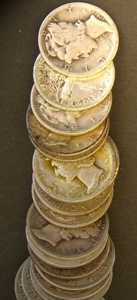MERUCRY DIME SPECIFICATIONS
1916-1945
Designer: Adolph Alexander Weinman
Weight (grams): 2.5
Weight (grains):
Size: 17.9 millimeters
Composition: 90% Ag; 10% Cu
Total Silver Content (oz.): .07234
Nicknames: "Mercury Dimes"
Fully Split Bands
On the coin's reverse, the fasces (bundled stick in the middle) has three bands - top, center and bottom. On fully struck coins with outstanding detail (and collectability) the center bands are what is called 'fully struck'. These Fully Struck Bands (FSB) coins carry a price premium. The mercury dimes with the lowest number of FSB coins are these dates:
1919-S, 1927-S and 1942/1 and1945-P are the rarest dates with FSB. Indeed, the true numbers are probably less than the third party certification records indicate, since collectors re-submit coins in hope of achieving even better grade for these rarities.
Mercury Dime Varieties:
When Mercury Dime dies wear, distortion – especially along the rims – produce a wide variety of apparent varieties. However, these worn editions are not recognized as true varieties among collectors. Here are the ‘established’ errors and varieties:
Varieties:
1928-S Large and Small S
1929-S Double Date at IGWT
1934-D Large and Small D
1931-S Doubled Die Obverse [FS-101]
1936 Doubled Date
1942-D Doubled Die
1941-D Doubled Die Obverse and Reverse [FS-101]
1941 S Large and Small S
1941 S Doubled Mintmark
1941-S/S Re-Punched Mintmark [FS-502]
1942/1 Overdate Error
1942/1-D Overdate Error
1942-D Doubled Die
1942 D/D
1943-S Trumpet Tail Mintmark [FS-511]
1944 Doubled Die
1944-D Doubled Die
1945-D D/Horizontal D [FS-506]
1945-S S/Horizontal S
1945 Doubled Mintmark
1945 S Micro S
The 1945 S dime has a normal sized S mintmark and a micro sized one. This is because the micro s was a stamp used for another country's coinage but produced in the US. Now, there are other coins with micro-s including the 28s. Also, although not widely published, the 41s also has the micro-s.
Mercury Dime Strikes
Placement of mint marks vary because the mark was hand stamped onto the die. However, size and positioning of the mint mark became more standardized into the later 1940s.
1916-D Diagnostic: The Mintmark
Lange's Complete Guide to Mercury Dimes notes that on all four die pairs the mintmark shows as the exact same shape. The D looks boxy and has crisp parallel serifs on the left and remains strong even on well worn coins.
1941/2 Diagnostic
The diagnostic on this famous error coin is on the reverse. In the field between the fasces and the rim, near 7 O’clock, is a die gouge visible under 10x magnification.

